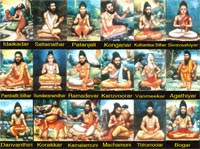At the time the Siththars were living, they were staying away from the common people. Their thoughts are liberal which is helpful even till today. We can show many evidences for that in their songs.
Whatever it is, we can clearly understand that the Siththars have created a very strong bond among themselves. The evidences for this are that one Siththar shares about the greatness of the other or recognizes him. We can realize this from the Siththars who were living on the Sathuragiri Mountain who has always shared the good and greatness of the other Siththars living there. Along with this we can also realize that they did not want their researches to reach to people apart from themselves.
Though they say that the reason behind hiding them is to prevent it from reaching the hands of the bad people, I feel there is some other strong reason also. It might also be an opinion that their researches should not reach to the people who did not recognize them. They have told about the various herbs present in the Sathuragiri Mountain. Along with that they have also told that in future, people will come in search of those herbs. As an evidence to this I shall share two songs of Agathiyar.
This song is taken from the book “Agathiyar 12000” where he says the following song to his disciple Pulathiyar.
"சித்தான சித்துமுனி சொரூபரப்பா
Siththaana siththumuni soroorappa
யின்னமுண்டு உரைப்போம் கேளு
yinnamundu uraippoam kaelu
முத்தான புலத்தியனே முடிமன்னா
muththaana Pulathiyanae mudimannaa
மூவுலகில் என்றுமுண்டு சித்தர்வர்க்கம்
moovulagil enrumundu siththarvarkkam
வெத்தியுள்ள சதுரகிரி வடபாகத்தில்
veththiyulla sathugiri vadapaagaththil
என்றுமிருப்பார் ரனேகம்பேர் நாதர்தாமும்
enrumiruppaar ranaegam paer naatharthaamum
பத்தியுடன் நாதாக்கள் தன்னைக்காண
paththiyudan naathaakka thannaikkaana
பாருலகில் வெகுமாண்பர் போவார்பாரே
paarulakil vegumaanbar poavaarpaarae"
- அகத்தியர் (Agathiyar)
"போவாரே அம்மலையின் அதிசயங்கள்
poavaarae ammaaiyin athisayangal
கோடான கோடிமூலி யனேகமுண்ண்டே
koadaana koadimooli yanaemundae
யனைத்தையுமேய ழித்திடவே முனைவர்
yanaiththaiyumaeya zhiththidavae munaivar
மானமுடன் வையகத்தில் மூலிவாழ
maanamudan vaiyagaththil moolivaazha
நலமுடனே வெகுகாலம் காக்கவேண்டி
nalamudanae vegukaalam kaakkavaendi
நலமுடனே வெகுகால மிருந்துகொண்டு
nalamudanae vegukaaa mirunthukondu
கோடியாம் மாண்பருக்கு கண்ணில்காணா
koadiyaam maanbarukku kannilkaanaa
குணமுடனே மறைத்தார்கள் நாதாக்கள்தானே
Kunamudanae maraiththaarkal naathaakkalthaanae”
- அகத்தியர் (Agathiyar)
The Siththars are immortal, they can always be seen in the northern side of the Sathuragiri Mountain. People will start visiting the Sathuragiri Mountain to get their blessings. Those people who begin to come will start destroying the wonderful places and the rare herbs. That is the reason why the Siththars have kept the information about these herbs as a secret. Only few herbs that need not be protected are availabe to the people and those which has to be protected are still hidden in the places where these people could not reach.
Today in the Sathuragiri Mountain, this is the situation. As the people are moving around in more number, the forests are being destroyed thereby cutting of these valuable herbs also. But still if we make researches following the instructions of Agathiyar as told in his books, we can know about those herbs.
Agathiyar has also told about the way of identifying these herbs that are hidden. As the length of the post increases, I am not sharing them here.
Original – www.siththarkal.com

